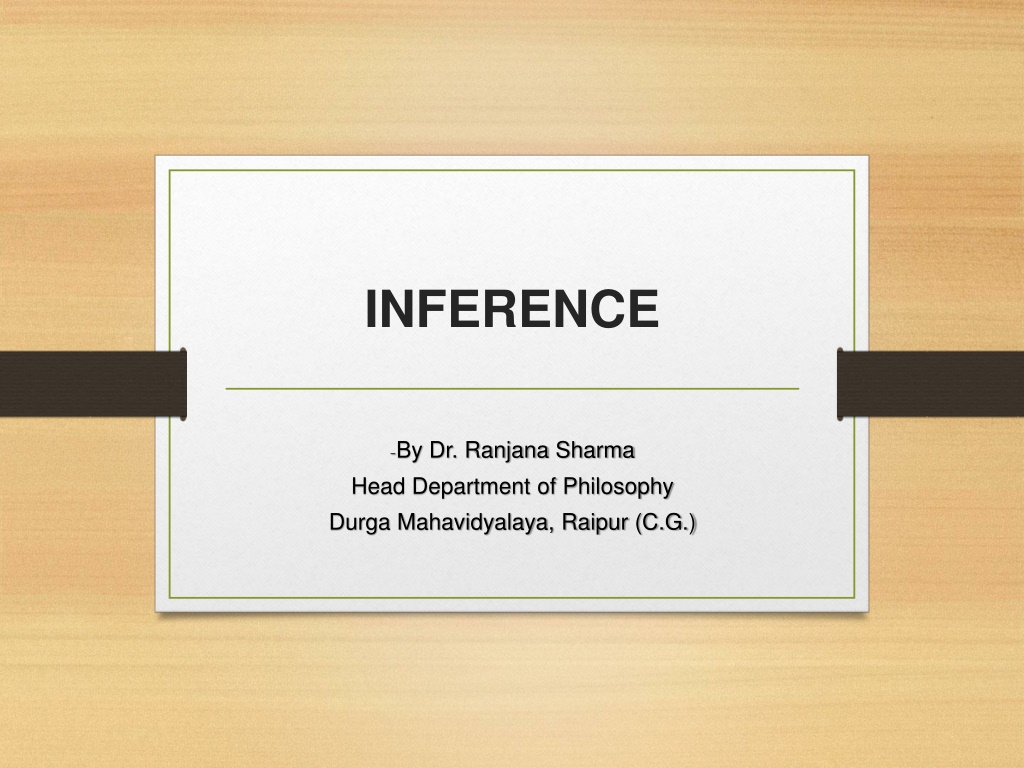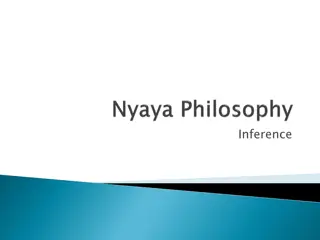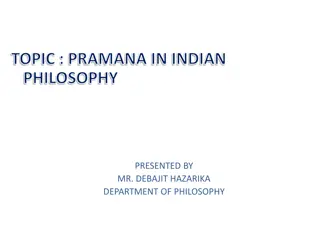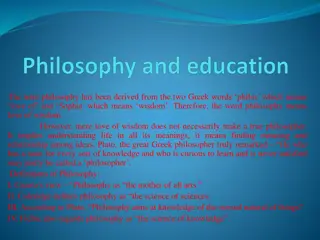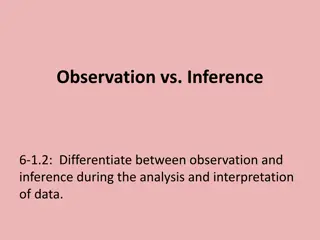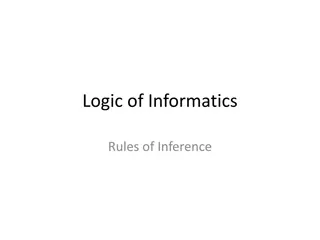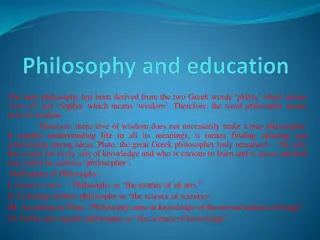Understanding Inference in Indian Philosophy
In Indian philosophy, inference is considered one of the six ways to attain true knowledge. It involves three constituents: Hetu (middle term), Sadhya (major term), and Paksha (minor term). The steps of inference include apprehension of the middle term, recollection of the relation between middle and major terms, and cognition of the major term in relation to the minor term. The grounds of inference rely on Vyapti, the invariable concomitance between the middle and major terms. Types of inference are classified based on purpose and nature, offering insights into different approaches to reasoning.
Download Presentation

Please find below an Image/Link to download the presentation.
The content on the website is provided AS IS for your information and personal use only. It may not be sold, licensed, or shared on other websites without obtaining consent from the author. Download presentation by click this link. If you encounter any issues during the download, it is possible that the publisher has removed the file from their server.
E N D
Presentation Transcript
INFERENCE -By Dr. Ranjana Sharma Head Department of Philosophy Durga Mahavidyalaya, Raipur (C.G.)
Definition Of Inference In Indian Philosophy true knowledge is Prama and to obtain this true knowledge there are six ways i.e. six Pramans. Inference [Anuman] is one of them. Anumana [inference] literally means a cognition or knowledge which follows Example- The hill is fiery, because it smokes and whatever smokes is fiery . In this example, we pass from the perception of smoke in the hill to the knowledge of the existence of fire in it, on the ground of our previous knowledge of the universal relation between smoke and fire. some other knowledge.
The Constituents of Inference Inference has three constituents- Hetu- Smoke, the apprehension of smoke.[middle term] Sadhya- Fire, as we observed in the past the invariable relation between smoke and fire.[major term] Paksha- Hill, in context of which smoke is perceived and fire is unperceived.[minor term]
Steps Of Inference The first step in inference is the apprehension of the Hetu [smoke] in the Paksha [hill]. The second step in inference is recollection of the universal relation between Hetu [smoke] and Sadhya [fire]. The last step in the inference is the cognition of the Sadhya [fire] as related to the Paksha [hill].
The Grounds Of Inference The ground of inference is Vyapti . Vyapti is invariable concomitance between middle term[Hetu],smoke and major term [Sadhya] , fire. The smoke is always accompanied by fire. Real Vyapti must be unconditional or free from Upadhis [condition]. There must be Upadhiniras invariable concomitance between Hetu and Sadhya , their relation must be unconditional, it should not depend on any condition. in Vyapti means
Types Of Inference First classification of Inference is based on purpose.There are two kinds of inference- A.Swartha inference-This inference for oneself. There is no fix steps ,it may be in any order ,first conclusion then premisses or first premisses then conclusion. B.Parartha inference-This inference meant for others. It must be in this way- Ram is mortal.[Pratigya] Because he is a man.[Hetu] All men are mortal ,e.g. Mohan, Sohan ,Suresh .[Udaharan] Ram is also a man.[Upanaya] Therefore he is mortal.[Nigamana]
Second classification of inference is based on nature. There are three types of inference- 1.Purvavat inference-Purvavat inference is that in which we infer the unperceived effect from a perceived cause i.e. the inference of future rain from the appearance of dark heavy clouds in the sky. 2.Sheshvat inference-Sheshvata inference is that in which we infer the unperceived cause from a perceived effect i.e. the inference of past rain from the flood in the river. 3.Samanyatodrisht inference We infer the one from the other not because we know them to be causally connected but because they are uniformly related in our experience. This is illustrated when ,on seeing the different position of the moon at long intervals, we infer that it moves, although the motion might not have been perceived by us.
Third classification of inference is based on method. There are three types of inference- 1.Kevalanvayi inference-An inference is called kevalanvayi when it is based on a middle term which is only positively related to the major term. 2.Kevalvyatirek inference- A kevalvyatirek inference is that in which the middle termis only negatively related to the major term. 3.Anvayavyatirek inference- Anvayavyatirek inference is both positively and negatively related to the major term.
